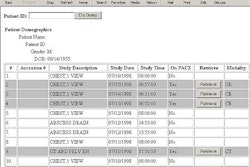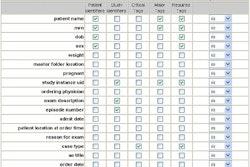Referring physicians increasingly prefer online scheduling of radiology procedures to the traditional telephone method, and may change providers if their scheduling experience is unsatisfactory, according to a research team led by Dr. Biswata Mozumdar from the National Institutes of Health in Bethesda, MD.
To test their hypothesis of a difference in satisfaction between users who schedule online versus those who use the telephone, the researchers performed an e-mail survey of 60 physicians who referred patients to a single, large academic radiology department. The results were described in a poster presentation at the 2003 Symposium for Computer Applications in Radiology (SCAR) in Boston.
The survey was designed to identify the physician's preferred patient scheduling medium, and whether ease of scheduling was a factor in referring patients to other providers. Physicians were also asked to provide comments and suggestions for improvement.
In addition, radiology scheduling personnel were interviewed to identify areas that presented difficulties for referrers. Interviews were also conducted with staff members in the key referring physician offices, one each in the offices of the internist group practice, orthopedics group practice, and the surgical clinic of a large health maintenance organization.
Of the 33 survey respondents, 26 (78.8%) indicated they were willing to try to schedule online. Sixteen of the 26 actually tested the system. Two staff members were interested in online scheduling, but did not have online access. The researchers gathered from interview results that the others did not have the option to schedule online.
Of the 16 respondents who tried online scheduling, 12 said it was an easier method of scheduling patients. Three (18.75%) said the online system did not simplify scheduling, citing difficulties with patient preparation and arrival time. One user did not indicate a preference, according to the researchers.
Eleven of the 33 survey respondents told the researchers that they changed providers if they were dissatisfied with the patient scheduling experience at a particular provider. Of the 16 who tried online scheduling, five (31.25%) said their choice of radiology service providers would be subject to change due to scheduling ease, the authors wrote.
In the interviews, the researchers heard criticism relating to the long queues during telephone scheduling and the "move-up" list.
"Although electronic order entry is the preferred method, it still offers scope for improvement -- communicating pre-procedure preparation instructions effectively, scheduling urgent/emergency cases, and scheduling multiple tests simultaneously," the researchers wrote. "The telephone facilitates urgent/emergency appointments and multiple test scheduling, but long telephonic queues and rescheduling of preexisting appointments (the 'move-up' list) present formidable problems."
The group added that it might be a viable strategy to tailor the capabilities of an existing scheduling system, both online and telephone, to meet and exceed referring physician expectations.
"Online scheduling applications are becoming the preferred scheduling vehicle," the authors concluded. "Augmenting their capabilities and availability can simplify the scheduling process, increase efficiency, improve referring physician satisfaction, and provide a competitive advantage. Referrers are willing to change providers if scheduling expectations are not met."
By Erik L. RidleyAuntMinnie.com staff writer
July 3, 2003
Related Reading
RIS/PACS integration -- what is it and what are its benefits?, June 6, 2003
Web-based integration of PACS and RIS systems improves workflow, patient care, May 12, 2003
Imaging centers ready to handle cost-conscious market, April 3, 2003
Hospital-physician collaboration can alleviate radiologist shortage, March 26, 2003
Marketing the radiology practice with a professional Web presence, February 6, 2003
Copyright © 2003 AuntMinnie.com




















